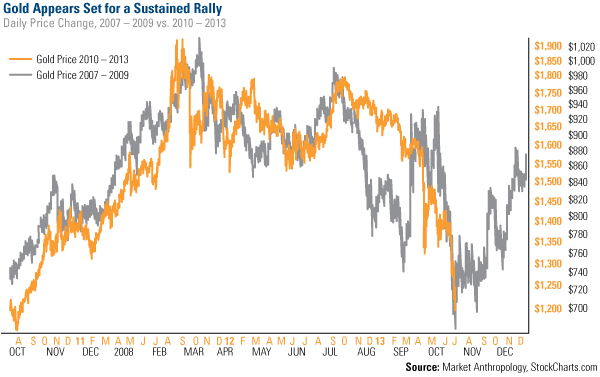Gold Market Radar (July 8, 2013)
For the week, spot gold closed at $1,222.89, down $11.68 per ounce, or 0.95 percent. Gold stocks, as measured by the NYSE Arca Gold Miners Index, declined 4.7 percent. The U.S. Trade-Weighted Dollar Index rose 1.50 percent for the week.
Strengths
- New data shows physical demand for the yellow metal remains as robust as ever in China. Net Chinese gold imports jumped 40 percent in May from the month before. Analysts at Stifel Nicolaus noted that China has already imported about 20 million ounces of gold in 2013, compared to 26.7 million in all of 2012 and 13.8 million in all of 2011. If these import numbers hold up through the year, they would equal to 50 percent of global mine production. Or as Paolo Lostritto of National Bank Financial puts it, the Chinese buying exceeds the total GLD ETF liquidation.
- Mineweb reports a South African physical platinum ETF holdings race to 500,000 ounces just 10 weeks after its launch. Holdings of Absa Capital’s platinum-backed exchange-traded fund have risen to account for about a quarter of all global platinum ETF reserves. The ETF is now the second-largest physical platinum ETF after New York-based ETFS Physical Platinum Shares, which holds 611,847 ounces of metal and took two years since inception to hit the half-a-million ounce mark. The South African fund has seen strong interest since launch, indicating very healthy appetite for physical investment in South Africa, according to Mitsubishi analyst Jonathan Butler. The unprecedented interest also highlights the appetite for physical precious metals by South African pension funds and other investment funds in emerging markets, which are constrained to invest in their local markets and are unable to benefit from purchases of oversold physical metals in the New York or London markets.
- Dundee Precious Metals has started work at its Tsumeb smelter in Namibia to eliminate the sulphur dioxide emissions and at the same time create a viable byproduct, sulphuric acid, which could be sold to other mines operating in Namibia. The acid plant will turn a problem into increased revenues for Dundee. Discussions are already underway for possible off-take agreements with local mines.
Weaknesses
- Gold Fields Ltd. Chief Executive Officer Nick Holland was quoted saying bullion must rise to $1,500 an ounce for the gold mining industry to be sustainable. “The industry is not sustainable at $1,230 an ounce, which is where the gold price is at the moment,” Holland said today in a telephone interview. “There’s going to be significant rationalizing in the gold industry,” Holland added. The comments come as analysts began commenting on the possibility of mine closures as gold producers can’t keep mines running while losing money.
- Jefferies published a very critical report this week stating gold is a commodity whose price can rise or fall, and an argument could be made that gold equities should trade at valuation discounts just like any other resource equities. The reports highlights rising costs, rising political risks and a stagnant commodity price, as reasons why dissatisfied investors have been exiting the market, bringing about selling that could beget selling and send the gold price lower.
- In the past 10 years, 55 gold and silver companies analyzed by BMO Capital Markets have increased their net debt, or debt minus cash, from less than $2 billion to a record of $21 billion. Low interest rates made debt a more attractive option as companies embarked on enormous capital expenditure projects, and a massive industry consolidation drive. Barrick Gold Corp. and Kinross Gold Corp. are trading as if they’ve lost their investment-grade ratings despite Moody’s rating them grade Baa2 and Baa3 respectively. The result is that of miners scrambling to cut costs, as the higher yields threaten to add to the already increasing costs of future borrowing.
Opportunities
- Market Anthropology published the chart above in a report titled “The Case for Buying Precious Metals.” The report highlights the four reasons why they turned bullish on gold: First, the downside momentum went from gradual decline to waterfall cascade, signaling the overreaction caused by the media. Second, on purely technical terms the sector has extended beyond historical extremes. Third, they don’t have a favorable opinion for the U.S. dollar or for rising yields. Lastly, what they call “anecdotal evidence” of prominent bulls capitulating on the sector inevitably links gold with the banks low in 2009. The report brings attention to multiple valid comparisons between the sector and the desperate selling of 2009, and concludes that, as “outlandish as it seems right now – perhaps [gold’s] best days are yet to come.”
- Despite the Labor Department’s statement that nonfarm payrolls swelled by 195,000 jobs in June, and its upward revision of job gains for May and April, Gregory Weldon offered a word of caution, as it “specifically applies to the “strength” of today's U.S. macro-data.” According to Weldon, reading beyond the headlines one could find the following data: Full-time jobs decreased by 240,000, while part-time jobs increased by 360,000, meaning full-time employment actually decreased in June. Furthermore, 253,000 people left the labor force in June, meaning more people dropped out, than found jobs. Similarly, the number moving from Employed to Unemployed was larger than the number of people who moved from Unemployed to Employed: 79,000 vs. 153,000. Weldon accurately concludes the so called ‘strength’ of U.S. macro-data is nowhere nearly as robust as the headlines suggest.
- UBS has officially started storing gold for clients at a vault in Singapore, as Asian investors chase after the yellow metal notwithstanding the drop in prices. The Singaporean government has done its part by removing a 7 percent sales tax from investment-grade precious metals last year. McKinsey & Co. estimates millionaires in Asia outside Japan will create $7 trillion in new wealth by 2016, adding pressure to the unprecedented physical demand in Asia.
Threats
- The link between Fed monetary easing and the growth of the money stock delinked after 2008 when the Fed began to pay interest on excess reserves. The interest rate induced the banks to maintain excess reserves at the Fed instead of lending. The result is money stock growth of just 1.5 percent a year from 2008 to 2012. Thus, it is not surprising that inflation has remained so moderate, and that quantitative easing has done so little to increase real economic activity. However, when businesses and households increase their demand for loans, and commercial banks meet that demand with new lending, the resulting growth will become a source of unwanted inflation.
- An anticipated write-down of $4.5 billion to $5.5 billion on Barrick Gold’s Pascua-Lama project would eliminate the company’s $3.9 billion in retained earnings. That is not all; Analyst Greg Barnes of TD Securities estimates Barrick’s write-downs could total $10 billion. The company’s carrying value of its assets assumes future revenues at a gold price of $1,700 an ounce, far above the current level. Additionally, Barrick calculates its gold reserves at $1,500 an ounce. The implication, not only for Barrick, but for other miners too, is that any impairment testing at a current gold price would likely result in necessary write-downs.
- The Reserve Bank of India attack on gold imports has become so desperate that bank officials have taken to urging the populace, at each and every available occasion, to desist from buying gold. The bank has suggested reducing gold imports would automatically reduce the current account deficit in the country, at the same time stifling all lines of credit for gold purchases. In our opinion, the bank’s efforts will continue to be futile; in April and May the import of precious metals stood at $15.88 billion. Furthermore press reports are stating the obsession to bring gold into India has reached unprecedented levels with authorities acknowledging the smuggling from Dubai is rampant.

















